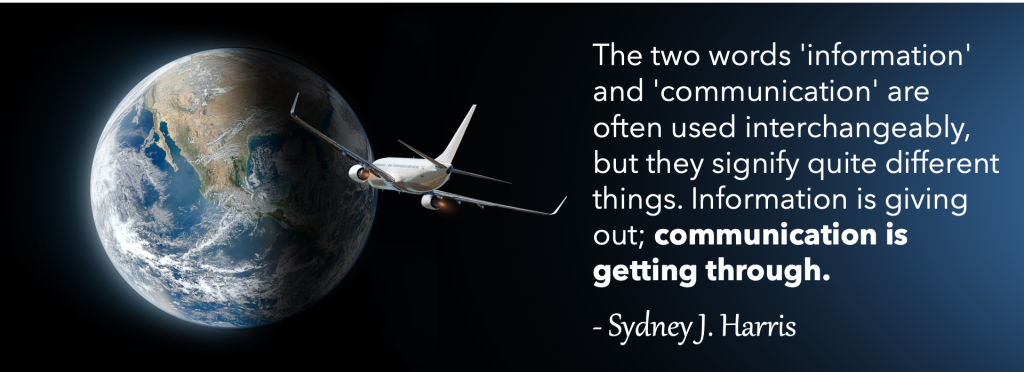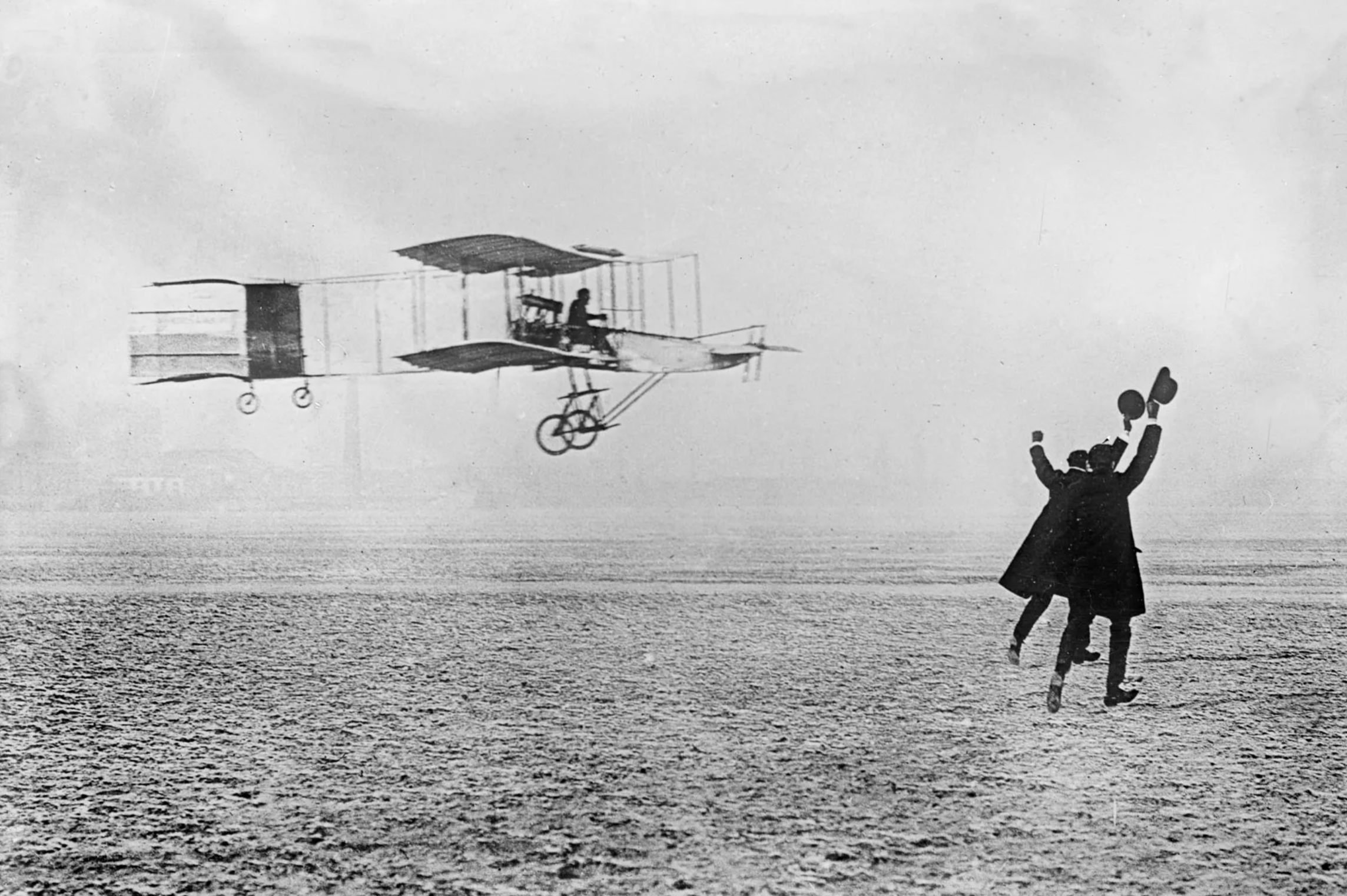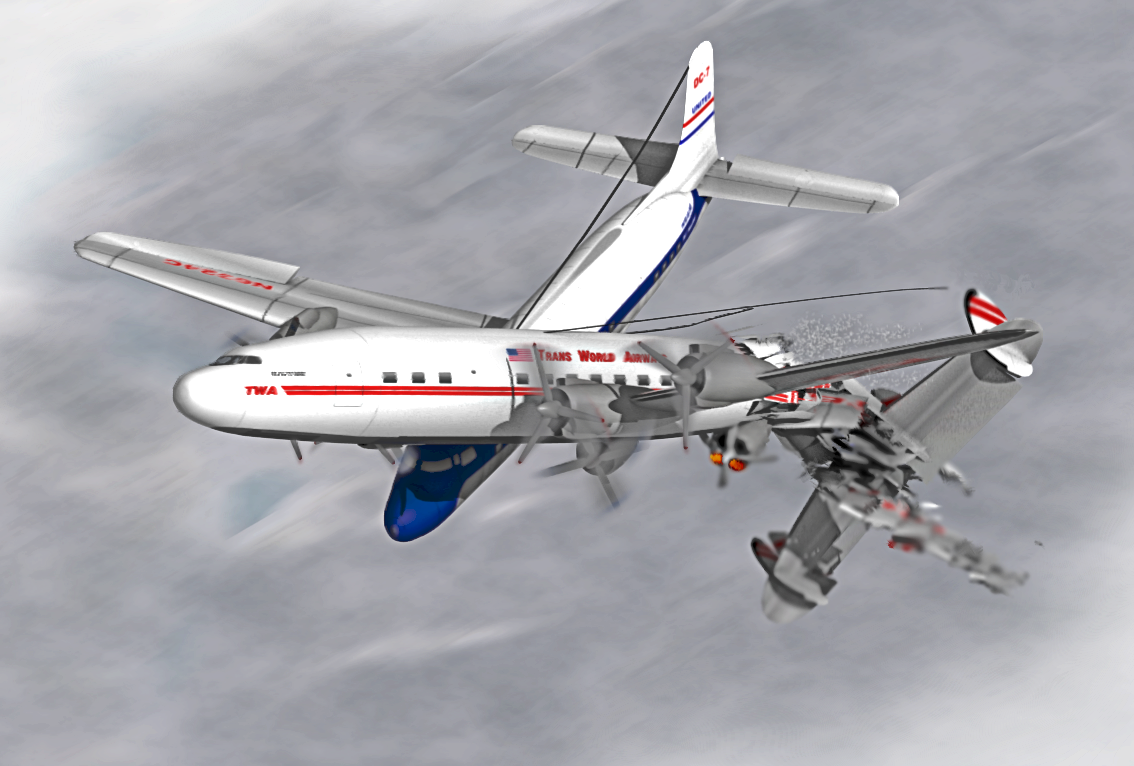1.6 Communication in Aviation
McDonald Kyte
 (Schulmeister, 2021). Image: From Adobe Stock by AlenKadr / Education License – Standard Image
(Schulmeister, 2021). Image: From Adobe Stock by AlenKadr / Education License – Standard Image
Why is communication important in the aviation industry?
Aviation communication is a crucial component pertaining to the successful functionality of aircraft movement both on the ground and in the air. Effective communication reduces the risk of an accident, ensures the safety of passengers and crew, as well as complies with regulations and standards.
The earliest communication with aircraft was by visual signalling (Figure 1.6.1). On August 27, 1910, James A.D. McCurdy, a Canadian aviation pioneer, achieved the world’s first air-to-ground wireless communication from a heavier-than-air flight. While flying over the Sheepshead Bay race track in Brooklyn, New York, McCurdy transmitted a Morse code message to Henry M. Horton (Government of Canada, 2019). Following World War I and World War II, new technology was developed to increase the range and performance of air-to-ground and ground-to-air communication with planes.
 Figure 1.6.1 On January 13, 1908, French aviator Henri Farman Won with his Voisin-Farman I the Grand Prix d’Aviation for the first circular flight of more than 1 km (Crouch, 2024).
Figure 1.6.1 On January 13, 1908, French aviator Henri Farman Won with his Voisin-Farman I the Grand Prix d’Aviation for the first circular flight of more than 1 km (Crouch, 2024).
When aviation was still in its early stages, the general assumption was that the sky was too expansive for two planes to randomly collide, until the horrific air collision of two planes over the Grand Canyon on June 30, 1956 (Cloudberg, 2023). On that day, a Trans World Airlines (TWA) Super Constellation L-1049 and a United Airlines DC-7 collided in clear airspace at an altitude of 21,000 feet above the Grand Canyon, resulting in the deaths of all 128 individuals on board both aircraft. This tragic accident prompted a significant effort to revolutionize and enhance aviation safety, ultimately leading to the establishment of the modern Federal Aviation Administration (Desert View Point and 1956 Aviation Memorial, n.d.). That crash also prompted the beginning of better aviation safety in all aspects of aviation, including addressing proper communication.

Figure 1.6.2 Artist’s rendition of United Airlines Flight 718 colliding with TWA Flight 2. This impression is the one of the most accurate depiction of the collision (Wikimedia Commons, 2010)

From Ideas to Impact: Mastering Technical Writing for the Workplace
Technical workplaces are highly collaborative. You will never work in perfect isolation and there is no way you can avoid communication in the technical workplace. In fact, “where there’s a need to communicate, there’s a need to write” (Ewald, 2017, p.1). As we discussed earlier, technical writing is a simple, straightforward means of writing designed to fulfill a task, and the goal is to convey information to people who need it and who will use it to take action. Hence, technical writing is meant to be clear, concise, and effective, that is, understandable, readable, and useful.
Technical writing differs from the other forms of creative, literary, or academic writing in its purposes. Technical writing is primarily focused on conveying information in a clear, concise, and instructive manner. It explains complex ideas, processes, or procedures in fields such as science, engineering, technology, and business. The main goal of technical writing is to inform, educate, or guide the readers in a specific task or understanding of a subject. On the other hand, literary writing is more focused on artistic expression, creativity, and evoking emotions or exploring themes and ideas. It encompasses various forms such as novels, short stories, poems, and plays, and its purpose is often to entertain, inspire, or provoke thought. Literary writing often involves the use of figurative language, symbolism, and narrative techniques to create a rich and immersive experience for the reader. In short, technical writing aims to inform, instruct, and persuade. The ultimate goal is its usefulness and usability – helping the reader to understand and manage the information by completing a specific task.
Let’s take a look at Edgar Allan Poe’s poem To Helen (Academy of American Poets, 1850):
Helen, thy beauty is to me
Like those Nicéan barks of yore,
That gently, o’er a perfumed sea,
The weary, way-worn wanderer bore
To his own native shore.
To express these ideas in technical writing, we would simply say:
Helen is beautiful.
And that is the essence of technical communication – transforming complex and challenging content into clear and concise documentation that is understandable for the target audience. This does not mean that technical writing is easy. Like any skill, it requires preparation, effort, and practice. In fact, learning to write well plays to the strengths of people in the technical fields. As a technical professional, you should be good at working within structured systems that follow rules and guidelines. You are trained to work according to specifications and to apply rules and best practices consistently (Ewald, 2017). Hence, the CMAPP Model provides a suitable approach to technical writing.
CMAPP Model:
The acronym CMAPP stands for context, message, audience, purpose, and product. The CMAPP model, developed by communication scholars, will help you ask important questions, manage the complexity of the information, and adapt your style and tone depending on the writing situation that ultimately shapes your communication (Balzotti, 2018). Communicators must think about and respond to each of these factors appropriately. CMAPP is a dynamic analysis model that provides a practical guide for a variety of communication strategies.
The different elements of the CMAPP model will guide you in the technical writing process by keeping in mind the factors that will set you apart as an extremely effective technical communicator.
Context:
Context in communication refers to the environment or setting in which communication takes place, which includes elements like the physical setting, the psychological environment, and the cultural backdrop. When communication takes place, context works to interpret parts of the message/content. There are several factors you should consider such as economic, physical, ethical, or political.
Context is both always present and ever-changing — different people understand and use different information differently. To be an effective communicator, you must be able to understand the context and adjust when needed. For instance, the context of using an instruction manual is different from that of discussing a proposal or analyzing a technical report. Remember that readers are the focus and make note of any changes in context that can and should affect the way you present information to your audience.
Another important factor to consider within context is taking note of your audience’s background, roles, and responsibilities. People decode and understand what they read within the context of given circumstances. As a result, they respond to each message in light of the previous situation as well as their understanding of the people and groups involved. We will discuss in detail how to ‘Create a Reader Profile’ in section 2.1. Other factors could influence your writing including your company culture, interpersonal relationships with the readers involved, preconceived ideas, and how your technical communication will be received. Hence, it is important to consider the context to create an audience-centred communication and adapt the techniques to the specific needs of the audience.
Message:
When we talk about the message of your communication, we are referring to its content. Identifying the content and being able to prepare and encode it clearly and concisely in your head before attempting to communicate it is essential in technical communication.
Depending on the type of the message and length of the message, you should adapt specific writing techniques to cater to the needs of your audience. This can also help you decide the best way to communicate the message with an appropriate level of formality, the amount of information required, the choice of words, and the document design.
Such meaningful insights and direction will help you to create proposals, reports, memos, emails, and technical documents most appropriate for today’s workplace. The emergence of digital and online tools will enable you to enhance readability and accessibility of the documents you create.
Audience:
The audience is the reader or group of people who will read your message. If the audience is familiar with the topic or the content, you would not have to provide as much context. If the audience is a colleague or technical expert, you would not be required to define specific terms. However, if your message is going to be read by a non-technical audience, you will be required to compose your message based on the needs of your audience. Hence, analyzing your audience will determine how you adapt your message to communicate technical information.
It is critical to determine what information your audience will need or expect from your communication. While every writing situation is different, it is generally useful to think of audiences as falling into a few broad categories: primary readers, secondary readers, and general readers. In other words, they are people who are decision-makers, experts or advisors, agents or implementors, and non-technical readers.
- Primary readers or Decision makers: Primary readers or decision makers are managers and supervisors. The information you provide will facilitate them to make decisions or take action about finance, policy, and administration. They appreciate summaries and the big picture to get the main point and clear context to figure out how your document fits into their business considerations as a whole. They would to know what you consider to be the most likely outcome or result of your recommendation.
- Secondary readers or Experts/Advisors: Secondary readers or technical experts have a thorough understanding of the technical details of your document. Their task is to read your documents and advise primary readers (decision-makers) on how they should approach your communication. They are experts and advisors in their field and they require detailed technical information such as calculations, statistical data, proofs and substantiations that support your conclusions and recommendations.
- Agents or Implementors: Agents or implementors are the readers who are required to carry out the tasks described in your document, such as office staff, machine operators, maintenance technicians, laboratory assistants, or installers. They require organized and accessible documents to find precise information and clear instructions or procedures so that they can follow your directions without having your technical expertise. They will also appreciate a clear explanation of why implementing the changes is necessary, what is the time frame, when and how the task needs to be done, and how it will affect and improve their operations.
- General Readers: Non-technical readers or general readers have the least amount of technical expertise and are generally outside your organization: for example, citizens reading a report on the effects of SAF (Sustainable Aviation Fuel) on Airline Operations, how fuel demand exceeds supply, the aviation industry’s commitment to sustainable flights, and so on. General readers need technical terms to be defined and explained. They benefit from the effective use of graphics that illustrate basic technical concepts, and they appreciate descriptions of how the content of the document will be useful to them. Depending on the situation, general readers can be decision-makers, for instance, if they are clients, stakeholders, investors, or community members who have a chance to support the organization or government’s action.
Purposes:
Technical writing has specific purposes tailored to the needs of its audience. These purposes can include informing, instructing, persuading, or directing.
- Informing: Technical writing informs the audience about a topic, providing factual information and explanations. This could include reports, manuals, or instructional guides.
- Instructing: Technical writing provides step-by-step instructions on how to perform a task or use a product. This could include manuals, how-to guides, or tutorials.
- Persuading: Technical writing aims to persuade the audience to take a specific action or adopt a particular point of view. This could include proposals, marketing materials, or persuasive emails.
- Directing: Technical writing provides clear guidance or direction to the audience. This could include policies, procedures, or guidelines.
- Each of these purposes requires a different approach to writing, depending on the intended outcome and audience needs.
Product:
The product of technical writing can vary depending on the specific purpose and audience. It could be a report, instruction manual, user guide, proposal, policy document, procedure, email, presentation, or any other form of communication that conveys technical information clearly and concisely. The purpose of the final product is to help the audience understand and use the information effectively to achieve their goals. The goal of a communication product is to effectively convey information to an audience, whether to inform, persuade, instruct, or direct.
Document Analysis Practice 1.6
Read the following factsheet about Cabin Waste and Single Use Plastics:
Sustainable Cabin: Cabin Waste and Single Use Plastics (SUP) Fact Sheet
Instructions for Document Analysis of a Technical Document:
Based on the contents of this chapter, analyze the Cabin Waste and Single Use Plastics Factsheet and discuss its improvement and effectiveness. Use the following points to guide your discussion.
Purpose and Audience:
- Identify the Purpose: What is the main objective of the document? Is it to inform, instruct, persuade, or report findings?
- Understand the Audience: Who is the intended audience? What is their level of expertise? Does the document meet the audience’s needs?
Structure and Organization:
- Examine the Layout: Assess the document’s layout and organization. Are headings and subheadings used effectively? Is the information logically organized?
- Check the Flow: Ensure that the content flows smoothly from one section to the next. Look for clear transitions and a logical progression of ideas.
Content and Clarity:
- Evaluate the Content: Is the information accurate, relevant, and complete? Are key points emphasized and supported by evidence?
- Assess Clarity: Is the language clear and concise? Are technical terms explained? Are instructions or explanations easy to follow?
Visual Elements:
- Review Graphics and Tables (if any): Are visuals such as charts, graphs, and tables used appropriately to support the text? Are they clear and well-labelled?
- Consider Design Elements: Evaluate the use of fonts, colours, and spacing. Is the document visually appealing and easy to read?
Usability and Accessibility:
- Test Usability: If applicable, follow any instructions or procedures outlined in the document to test their usability. Are they easy to understand and implement?
- Check Accessibility: Ensure the document is accessible to all users, including those with disabilities. Are alternative text descriptions provided for images? Is the document available in accessible formats?
Critical Evaluation:
- Strengths: Identify the strengths of the document. What aspects are particularly effective or well-done?
- Weaknesses: Identify areas for improvement. What aspects are unclear, confusing, or lacking?
- Suggestions for Improvement: Provide specific suggestions for how the document could be improved in terms of content, organization, clarity, visual elements, and usability.
3. Tips for Effective Analysis:
- Be objective and impartial in your evaluation.
- Use specific examples from the document to support your analysis.
- Consider the document from the perspective of different users, including novices and experts.
- Keep your analysis focused and concise, avoiding unnecessary details.
EXERCISE 1.6 Document Analysis
- Locate a document that is used in your workplace or find a document in a technical workplace through a search engine like Google. To find specific documents, type in keywords like “technical report,” “proposal,” “instructions,” and “presentation.” What characteristics make the document you found a form of technical communication? Develop a two-minute presentation for your class in which you highlight these characteristics of the document. (Adapted from Johnson-Sheehan, 2015, p. 16)
- Research online for a technical document, such as a report, proposal, user manual, or a set of technical instructions. Write a brief, one-page analysis of the document in which you discuss what you can observe or imply about the document regarding each of the elements of the CMAPP model. (Adapted from Balzotti, 2018, p. 20)
References
Academy of American Poets. (1850). To Helen. Poets.org. https://poets.org/poem/helen-0
Balzotti, J. (2018). Technical Writing Essentials (2nd ed.). BYU Academic Publishing.
Cloudberg, A. (2023, January 24). Into the abyss: the 1956 Grand Canyon mid-air collision. Medium. https://admiralcloudberg.medium.com/into-the-abyss-the-1956-grand-canyon-mid-air-collision-4dc9ba38f79a
Crouch, T. D. (2024, March 1). Henri Farman | Biography & Facts. Encyclopedia Britannica. Retrieved April 18, 2024, from https://www.britannica.com/biography/Henri-Farman
Desert View Point and 1956 Aviation Memorial (U.S. National Park Service). (n.d.). https://www.nps.gov/places/000/desert-view-point-1956-aviation-accident-memorial.htm#:~:text=1956%20Aviation%20Accident%20Memorial&text=On%20that%20day%2C%20a%20Trans,people%20onboard%20the%20two%20flights.
Ewald, T. (2017). Writing in the technical fields: A Practical Guide. Oxford University Press, USA.
Government of Canada. (2019, March 29). J.A.D. McCurdy: the father of Canadian military aviation – News Article – Royal Canadian Air Force. Canada.ca. (Date modified: 2021, February 22). https://www.canada.ca/en/department-national-defence/maple-leaf/rcaf/2019/04/j-a-d-mccurdy-the-father-of-canadian-military-aviation.html
Johnson-Sheehan, R. (2015). Technical Communication Today (5th ed.). Pearson.
Wikimedia Commons. (2010, April 4). File:1956 Grand Canyon mid-air collision.pnghttps://commons.wikimedia.org/wiki/File:1956_Grand_Canyon_mid-air_collision.png
Schulmeister, L. (2021, December 21). Information is giving out, communication is getting through. Oncology Nursing News. https://www.oncnursingnews.com/view/information-is-giving-out-communication-is-getting-through

